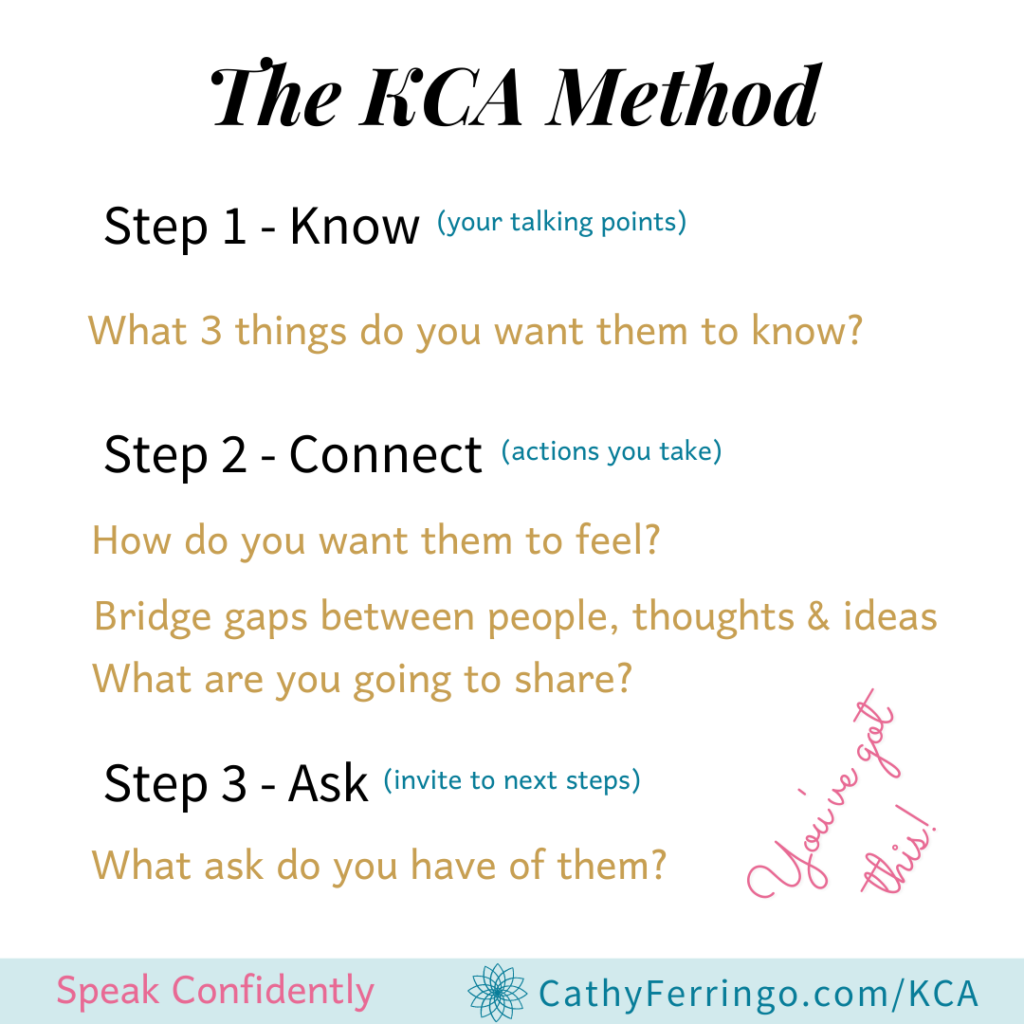Want to build your speaking skills? Are you wondering how to speak in a meeting without fear? How to actually be confident when it’s your turn to speak?
Whether it’s in a meeting, on zoom, or interacting in everyday life.
You can conquer your fear.
I’ve got some great tips to help you with stating your opinion, giving an update, interviewing, or actually providing a presentation.
Here’s my simple, easy, framework that will help you do it.
I’m a Business & Life Strategist, and Certified Professional Coach.
I help people, like you, every single day:
- Build their confidence,
- Become truly creative,
- Get out of their own way,
- Gain traction to actually achieve their goals
- – even the dreams they’re not quite willing to admit out loud yet.
You can have purpose & ambition too,
– @amibelle
they go together beautifully.
I created this framework to use for conquering your fear of meetings & public events – anywhere that you need to think and speak on-the-fly.
I’ll show you how to speak confidently without fear. You can overcome the fear of public speaking. It can be done with less effort than you’d think.
Using just three little words, and three easy steps, you can gain confidence in any speaking situation. I’ve used and taught them for years.
Plus I gave my method a snazzy name (KCA) to help you remember it.
The KCA Method
Step 1 – Know
This step forms your talking points.
What 3 things do you want them to know?
What do you want your audience to take away from your conversation with them?
- Be proactive at speaking at meetings
- yet don’t just speak for the sake of speaking, do it with thoughtfulness and purpose.
How To Speak More in Meetings:
If you’ve been asked or decided that you need to speak more in meetings instead of remaining silent (or passing) when it’s your turn.
- Look ahead at the agenda. You can see if there’s a topic coming up that you have an opinion on, – if not research and come prepared with 3 quick thoughts.
- Reach out ahead of time to the person hosting the meeting, the planned speaker, or your leader.
- It’s perfectly ok to ask them. “I see that X is on the agenda, and I’d really like to support you during the meeting and support the topic. Is there anything that I could prepare ahead of time, or is there anything that I can do to help support you?’
- Sometimes they will say “No, we just want to cover this, this, and this.”
- At least you have a little bit more of an idea of what’s to come to the meeting.
- This is great for introverts to know information ahead of time.
- Also note, it is ok to touch base even if an agenda is not offered.
- Sometimes they will say “No, we just want to cover this, this, and this.”
- It’s perfectly ok to ask them. “I see that X is on the agenda, and I’d really like to support you during the meeting and support the topic. Is there anything that I could prepare ahead of time, or is there anything that I can do to help support you?’
- Be open to learning – jot notes down as you learn in the meeting, and be ready to speak to the meeting topics. remember to take baby steps.
- By taking small steps you will speak up confidently in no time.
When Giving a Presentation:
If you know ahead of time that you will be presenting, you can have the three points ready that you want them to know. Prepare your thoughts and speech around those three main points.
This is good for agenda setting & also use the three points for a great recap at the end. (tell them what you’re going to tell them – tell them – then tell them what you told them.)
If You’re Asked to Bring an Update:
Ask yourself what three things have happened since the last meeting that this group of people might want to know about my area. so just have that ready ahead of time so make sure that you know three quick things that you want to talk about
For An On-The-Fly Request:
You can always be prepared
Listen in the meeting, interact during the meeting, and as the meeting goes along, jot 3 three things that come up that you’d like to go back to – or want to give credence to later.
It could even be that you want to bridge somebody’s thought with somebody else’s idea (which is also in part 2 of the KCA Method – so I’ll talk about it more in step 2.2).
There’s a million more possible scenarios for step 1 – but these are good for today.
Step Two – Connect
This step forms the actions that you take during the meeting
There is a variety of different ways to connect – I’ll cover three ways today.
You don’t have to have something for every one of these. It’s kind of the Choose Your Own Adventure part of the KCA method.
So after I go through the three of these you can decide how you want to connect with your group, then take action accordingly.
Step 2 – Option 1 – Feel
Ask yourself, “How do I want them to feel when I am done talking?”
It could be. I want them to feel supported. I want to be motivated and excited or confident.
I know, I know there’s a saying, “Don’t ever talk about feelings in business”.
Even before COVID research has said that at any given moment up to 30% – Only 30% – of the North American workforce felt engaged.
So if you don’t have engagement in your company, and you don’t have a connection with your coworkers, feelings might be the part that you’re missing out on. The “How do you want them to feel?” part.
Let’s address actual feelings. How do you want them to feel about the idea that you’re sharing?
Do you want them to feel like they are heard, informed, and inspired?
In an interview, you might want them to feel at ease and relaxed.
- So one of the actions I would probably take for that is to act as the host.
- Be the one that gets them comfortable with being in the room with you.
- Be the host and support them, to ensure that you’re letting them know that you are a confident person that would be great to be either part of the team if interviewing for a role or in front of their audience if interviewing for a podcast.
If you’re talking to other departments or executives or people that want to be in the know of something that’s going on in your area, they just might want to feel like they know what’s happening.
- So share with them. All of the information. Even the tough parts. Don’t sugarcoat everything for them.
- Be open, honest, and kind. Talk about feelings along with content. Describe how things are and how you working through any potential issues that arise.
Step 2 – Option 2 – Bridge
Like I mentioned earlier you might want to bridge the ideas, of other people in the room.
- If Sally has a great idea, and so does George. Say it. Say “Sally’s idea is great and so is George’s – what if we find a way to combine the two? How can we elevate their ideas”
- You can say offer ideas on how to combine them to make it work.
When you think of bridging, think about bridging the gap between ideas, thoughts, and people in the room.
Sometimes, while bridging you can point out other people’s skill sets that could help someone else.
- If so-and-so is saying that they’re working on X in their department. You might remember that somebody else has done that X before, so you can suggest that they connect.
- Go ahead and bridge people too, not just thoughts and ideas.
Step 2 – Option 3 – Share
If you don’t know what to say, think, or do when it’s your turn to speak.
Go ahead and share what it is you’re thinking or share what your next steps are.
- If a topic comes up and you just had a presentation, and you’re asked to comment or share your opinion.
- Then share what the next thing you’re going to do is say based on the information that you just heard today.
- “Here’s what I plan to do next when I go back to my team” Then tell them what you’re going to do.
So remember to connect. You can decide how you want them to feel, bridge ideas, thoughts, and people, or share how you’re feeling or what you’re going to do next.
Before we cover step number three – if you want a free copy of my KCA Method Planning Checklist – click here
I would love for you to use it as you plan your next presentation or while preparing to talk in front of other people.
Step 3 – Ask
This step forms the invite & path to possible next steps
What ask do you have of them?
Always, always, always, have an ask.
It can be any of the following (and more)
- Something relevant to the content
- Something forward-moving
- ‘Come see me with questions’ is an ask.
- Something that’s in line with your corporate goals
- You can even have default asks prepared
- I define this as something that you always ask that’s in line with your goals.
Here’s two real-life examples of a default ask:
- What I might do with my team in preparation for meetings with other departments is to ask the team “To help share our strategic value beyond just the number of calls that we answered in the service level we provided.” (key performance indicators of my department)
- When talking to other departments my default ask was “Contact us, and keep in touch, early and often”
- (for anything that might be changing in the company because we would probably get the calls first.
- Using these two default asks allowed us to be a source of information for the company.
- It also allowed us to be a strategic partner with other departments and it allowed us to support our coworkers.
- Plus it allowed our team to have a strategy for connecting in meetings.
- Those two back pocket asks, that I used, worked together to make sure that we were helping to achieve our corporate goals.
- A back pocket ask is a figurative tool that you can have in your back pocket ready to be used as needed.
Repeat after me I will always have an ask.
Having said that, I have an ask of you.
What small step in the KCA method could you put into practice this week?
What would help you be a little bit more comfortable with speaking to other people?
Will you jot down three speaking notes?
Will you make sure that you connect?
Will you have an ask when you’re interacting with the people?
Go ahead and practice. Then please, let me know how you’re doing. I would love to cheer you on.
If you feel this would benefit somebody else, please share it with them.

Now go out there and practice your new KCA skills.
Sneak Behind The Curtain View
For the keeners: here’s exactly how I used the three KCA steps here
- Know – my three main points are Know, Connect, Ask
- Connect – I want you to feel confident while trying to speak up so my actions were to show you ways that you could put it into practice (even providing sample words to say)
- I also made sure to give it a memorable (and silly name) that will help lighten the heaviness of the topic. If you’re nervous about speaking up, this is an easy framework to help get your thoughts together.
- Ask – I asked you to practice it and get back to me on how it went – I also asked you to share the video with anyone that could benefit from it.
Good luck in your quest to speak more confidently. Let me know if there’s anything I can do to help you.
Cathy
Get your free copy of the KCA Method Planning checklist
…………………………………………………………………………..
? Feature Photo by Yan from Pexels
The song I use in this video is called Morning Joe, it’s provided, with permission, by Patino.








